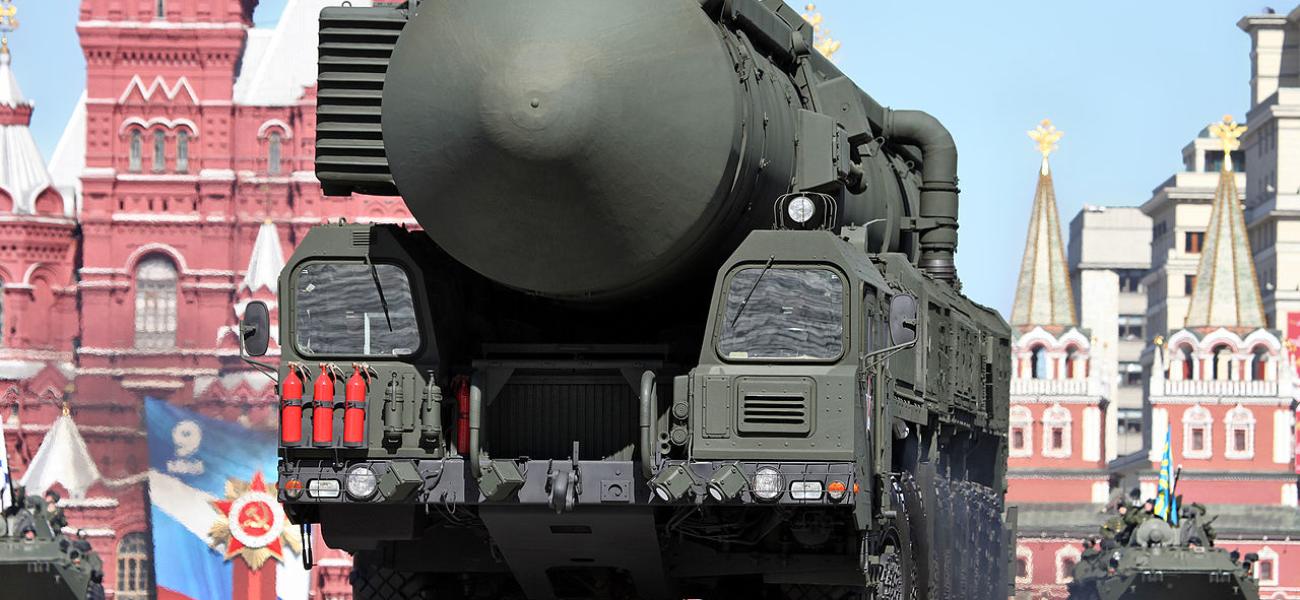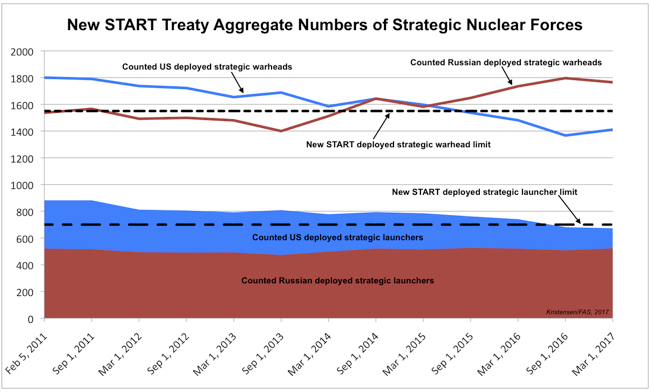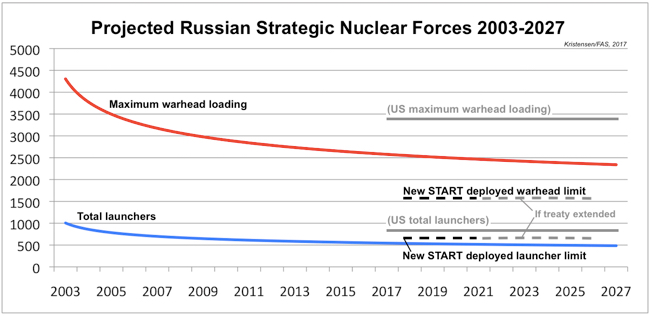
Russian Nuclear Forces: Buildup or Modernization?
As the February 2018 deadline for implementing the New START treaty approaches, fluctuations in the number of Russian deployed strategic warheads reported under the treaty and the overall modernization of Russia’s nuclear arsenal have triggered claims that Russia is expanding its nuclear arsenal.
Such claims are common from defense hawks and Russia critics, but recently even former secretary of the Air Force Deborah James fell into the trap when she told Real Clear Defense that “Russia is building up its nuclear arsenal.”
But Russia is not increasing its nuclear arsenal; it is modernizing it. And there certainly are important developments taking place within that force modernization. Yet commentators often appear to confuse or equate modernization with a buildup and pick specific developments out of context to make their (incorrect) point.
One development that really confused people was the New START treaty’s count of Russian deployed strategic warheads. For the first two years the treaty was in force Russia reduced its deployed strategic warheads. But in September 2013 the number started to go up. It continued to increase (except for a temporary dip in March 2015) until September 2016 when Russia was counted deploying nearly 1,800 warheads on its strategic launchers (see chart).

Because the increase happened at the same time the data showed the United States reducing its deployed strategic warheads to their lowest level since 2011, Russia at one point in September 2016 was counted as deploying 429 strategic warheads more than the United States. That really got the commentators riled up, but behind the numbers were more subtle developments that involved old weapons being retired or replaced by new systems. Sometime the two overlapped and gave the impression of an increase when in fact the overall trend was never in doubt: that Russia has continued to reduce its strategic nuclear forces and is expected to be in compliance with the New START treaty when it enters into effect in February 2018.
New START Implementation and Nuclear Force Modernization
Russia’s implementation of the New START treaty is, in a way, the least interesting part of the picture because Russia’s strategic nuclear forces structure is already well below the treaty limit and has been so since before the treaty was even signed. Under the latest count from March 2017, Russia had 523 deployed strategic launchers—177 below the treaty limit of 700 and 150 fewer than the United States. That is a considerable U.S. advantage that New START critics always forget to mention.
The deployed warhead number dropped in the March 2017 count and Russia has to reduce it by only 215 warheads by February to meet the 1,550 limit for deployed strategic warheads. That can be done by offloading a couple of old submarines.
It is much more important to monitor how Russia is modernizing its strategic nuclear forces. This modernization has been underway since the late 1990s and essentially involves phasing out all Soviet-era strategic nuclear weapon systems and replacing them with newer and better versions. The process is about 70% done and scheduled to be completed sometime in the mid-2020s.
The Soviet-era land-based intercontinental ballistic missiles (SS-18, SS-19 and SS-25) are being replaced with different versions of the SS-27 and a new “heavy” ICBM that has yet to be test-launched. Many of the silo-based ICBMs that used to carry multiple warheads have been replaced with single-warhead missiles; others will continue to carry multiple warheads in their new configuration. Russia’s previous very large force of single-warhead road-mobile ICBMs has been significantly reduced but the new ones will have multiple warheads.
Because Russia has significantly fewer strategic launchers than the United States, it is compensating by maximizing the number of warheads that each launcher can carry. There are currently a little over 1,000 warheads deployed on the ICBMs compared with 400 on U.S. ICBMs. But the New START treaty has no sub-limit for how many warheads may be deployed on what, so this discrepancy is the result of unilateral decisions made by Russia and the United States. And although Russia is modernizing its ICBM force, the U.S. Air Force National Air and Space Intelligence Center (NASIC) anticipates that “the number of missiles in the Russian ICBM force will continue to decrease because of arms control agreements.”
The other significant modernization involves the Russian strategic submarine force where Soviet-era submarines (Delta III and Delta IV) are gradually being replaced by new Borei-class submarines. This upgrade has been going more slowly than planned, not least because of initial problems with a new missile (SS-N-32 or Bulava) that have now been resolved. In the Pacific, the Borei has already begun to replace the Delta IIIs, which are the oldest, and will eventually replace the Delta IVs in the Atlantic as well. For now Russia has planned eight Borei subs but will probably increase that to 12 to have as many strategic submarines as the United States is planning under its modernization program.
A future twist is that the SS-N-32 can carry more warheads than the SS-N-18 and SS-N-23 missiles it is replacing (six versus three and four, respectively). That is fewer warheads than can be carried by a U.S. Trident II sea-launched ballistic missile, but it might force the Russian navy to deploy the SS-N-32s with less than the full warhead loading to keep below the New START force level in the future (the U.S. navy already deploys its missiles with less than full warhead loading).
The third part of the Russian strategic nuclear modernization concerns the heavy bombers, but this program is progressing at a much slower pace than the other two legs of the strategic triad because bombers are easier to upgrade. Russia has begun developing a new strategic bomber, but it is delayed; in the meantime Russia is modernizing or reproducing older bombers (Tu-95 and Tu-160). The Russian bombers are upgrading to a new nuclear air-launched cruise missile (Kh-102) to replace the old version (AS-15), but the upgrade appears to being going more slowly than anticipated. Under New START that doesn’t matter much, however, because the treaty doesn’t count actual bomber warhead capacity but arbitrarily attributes one weapon to each bomber no matter what it can actually carry (Russian and U.S. heavy bombers are not loaded with nuclear weapons under normal circumstances).
Overall, the Russian strategic modernization plan—as it has so far been described in public—appears to continue the trend toward fewer strategic warheads deployed on fewer strategic launchers. But as with the United States, the pace of the Russian reduction is much less than in the past and appears to be leveling out. A force projection looking 10 years into the future indicates that Russia is planning a strategic nuclear force that is a little smaller than today (see chart).

The projection comes with significant uncertainty because modernization plans are not fully known and defense budgets are under pressure from sanctions, low oil prices and related economic woes. But by the late-2020s, the Russian strategic nuclear forces might include around 500 launchers that can carry up to 2,400 warheads. That is a smaller force than the one planned by the United States, which will continue to operate more launchers that can carry more warheads in total. The number of launchers and warheads deployed at any given time will be much less than the maximum capacity, but it indicates that the current force structure balance is not expected to change significantly.
Although Russia’s invasion of Ukraine and the official adversarial relationship that currently exists have significantly changed the political and military relationship between Russia and the West, the forecast above largely reaffirms the conclusion made by the Department of Defense and the U.S. intelligence community in 2012 and its central strategic implication: The “only Russian shift in its nuclear forces that could undermine the basic framework of mutual deterrence that exists between the United States and the Russian Federation is a scenario that enables Russia to deny the United States the assured ability to respond against a substantial number of highly valued Russian targets following a Russian attempt at a disarming first strike” (here and below, emphasis is author’s).
Such a first-strike scenario “will most likely not occur.” Even if it did and Russia deployed additional strategic warheads to conduct a disarming first strike, even significantly above the New START Treaty limits, DOD concluded that it “would have little to no effects on the U.S. assured second-strike capabilities that underwrite our strategic deterrence posture.”
In fact, DOD stated, the “Russian Federation … would not be able to achieve a militarily significant advantage by any plausible expansion of its strategic nuclear forces, even in a cheating or breakout scenario under the New START Treaty, primarily because of the inherent survivability of the planned U.S. strategic force structure, particularly the OHIO-class ballistic missile submarines, a number of which are at sea at any given time.”
Non-Strategic Nuclear Weapons
There is considerable uncertainty about the size and composition of Russia’s non-strategic nuclear arsenal. Russia does not publish such information and Western intelligence agencies don’t want to say what they know. As a result, the public debate is awash with outdated information, confusion, rumors and exaggerations. Size estimates range from fewer than 2,000 warheads and upward.
Unlike the United States, which has largely transitioned from non-strategic nuclear weapons to advanced conventional weapons in its defense posture (only the Air Force retains non-strategic nuclear weapons for fighter-bombers), Russia continues to rely broadly on such weapons for national defense. It is a much smaller arsenal compared with the end of the Cold War (probably by a factor of 10), but all the military services appear to have them to a greater or lesser extent: air force, navy, army and air-defense forces.
The question, of course, is why. There is no certain answer but the predominant thinking is that Russia relies more on non-strategic nuclear weapons than the United States because it has weaker conventional forces; it uses non-strategic weapons to compensate against U.S./NATO (and increasingly also Chinese) superior conventional forces. NATO also used non-strategic nuclear weapons to offset Russian conventional arms during the Cold War; now the tables are turned.
Some defense hawks and nuclear advocates are also arguing that Russia has increased the role of non-strategic nuclear weapons in its defense strategy and is even entertaining scenarios for potentially using such weapons first very early in a crisis to discourage the U.S./NATO from counterattacking. This strategy has been coined “escalate to de-escalate,” but STRATCOM Commander General John Hyten says it’s more like “escalate to win.” As Russia’s relations with the West have deteriorated, some Russian officials have even made explicit nuclear threats against NATO countries. Others, including U.S. intelligence officials, privately say that claims about increased Russian reliance on early first-use of nuclear weapons are exaggerated and that U.S. strategy also relies on escalation to de-escalate and, if necessary, win a war; it can just wait longer because of its advanced conventional forces.
Moreover, as with Russia’s strategic nuclear forces, it is common to hear claims that Russia is expanding its non-strategic nuclear arsenal. The latest U.S. Congress defense authorization bill, for example, states that Russia has “continued to expand and diversify its arsenal of non-strategic nuclear weapons.”
Russia is certainly modernizing its remaining non-strategic nuclear forces (just like the United States), but the claim that Russia is increasing its arsenal is not supported by public information and appears to be inaccurate. The other claim, that Russia is diversifying its non-strategic nuclear arsenal, probably refers to the development and deployment of a new ground-launched cruise missile (SSC-8) in violation of the INF treaty; Russia denies the violation charge but, if true, it is a troublesome development that Russia should reverse.
In terms of the overall non-strategic nuclear arsenal, however, the numbers do not appear to be increasing and it is more likely that Russia’s ongoing modernization of its conventional forces will result in a reduction in the size of the non-strategic nuclear arsenal in the future. There are already signs of that trend.
Several Soviet-era warships that were equipped with dual-capable anti-ship cruise missiles (SS-N-9, SS-N-12 and SS-N-19) are now being modified to carry the SS-N-26 instead. NASIC says the SS-N-26 might have a nuclear capability, but the conventional version is significantly better than its predecessors so the future anti-ship strategy will likely rely less on nuclear weapons than in the past.
Similarly, although Russia is now fielding a new land-attack cruise missile (SS-N-30, widely known as Kalibr) that NASIC says “possibly” has nuclear capability, the new missile would—unlike the current land-attack cruise missile (SS-N-21)—also have conventional capability and be much more capable than its predecessor. The SS-N-30 is being deployed widely on Russian surface ships and submarines, but that doesn’t mean that every platform necessarily will be assigned the nuclear version. The old SS-N-21 was only assigned to select attack submarines, so it is possible (but unconfirmed) that Russia will continue that practice and leave the conventional land-attack mission to the surface fleet.
The Russian navy also relies on dual-capable anti-submarine rockets, torpedoes and depth bombs to defeat U.S. and NATO attack submarines threatening Russia’s secure second-strike capability onboard strategic submarines. Little is known in public about how this capability is evolving, but, similar to other defense areas, it’s probably declining as more advanced conventional capabilities are fielded. (The United States phased out all its nuclear anti-submarine weapons two decades ago.)
The one sub-category of Russia’s non-strategic nuclear forces in which there appears to be an increase and diversification is ground-launched nuclear weapons. Russia promised in the 1990s to phase out all of these, but apparently has retained some warheads for short-range ballistic missiles (SS-21, Tochka). That force is now being replaced with the SS-26 (Iskander) that is also dual-capable. And the allegations about INF violations, if true, would mean that the Russian army has started deploying a new dual-capable ground-launched cruise missile (SSC-8).
Finally, Russia also used to rely on nuclear warheads for air-defense and ballistic missile defense interceptors. Although the anti-ballistic missile defense system around Moscow (A-135) will likely continue to do so to some extent, the wider air-defense system is upgrading from the S-300 that used to include some nuclear interceptors to the more advanced S-400 and, later, S-500 that might rely less—if at all—on nuclear warheads. A decade ago Russian officials said they had cut 60% of the air-defense warheads, a downward trend that has probably continued. It remains to be seen to what extent U.S. stealthy aircraft and cruise missiles will sustain Russian reliance on nuclear-tipped air-defense interceptors.
Conclusions and Recommendations
Despite widespread claims about a Russian nuclear weapons buildup, the available public evidence indicates that, at least for now, that is not the case.
Both the strategic and non-strategic forces are undergoing significant and important modernizations, but indications are that Russia’s overall nuclear arsenal will continue to decline over the next decade.
That projection obviously comes with many uncertainties, not least the limited information about Russian nuclear forces in general and whether Russia-West relations will improve or continue to deteriorate.
Yet Russia will continue, as will the United States, to retain significantly more nuclear warheads in its arsenal than allowed to be deployed under the limit set by the New START treaty for February 2018. This enormous excess capability can and should be reduced by additional arms control initiatives. At the very least, Russia and the United States should extend the New START treaty by five years to keep the lid on the force structures.
But the large inventories of non-deployed warheads add uncertainty about intensions and fuel worst-case planning assumptions. Those inventories must be reduced or controlled by new arms control agreements.
Moreover, Russia’s large and diverse non-strategic nuclear arsenal continues to create concerns in Eastern Europe and presents numerous dangerous pathways for escalation to nuclear use in a conflict. These weapons are outside all arms control limitations, as are U.S. non-strategic nuclear bombs, an oversight that both sides must work to change.
The future of non-strategic nuclear forces is also closely related to the future of advanced conventional weapons. Both Russia and the West are fielding significant long-range conventional strike capabilities that will influence the role of nuclear forces. In some cases it may result in less reliance on non-strategic nuclear weapons, but in other cases it may reinforce and even increase their importance.
All of that underscores the continued importance of Russia and the West working to reduce nuclear force levels and dangerous deployments and strategies. In 2020 Russia and the United States will have to present their progress in implementing Article VI of the nuclear Non-Proliferation Treaty. Right now they don’t even have negotiations going on. Better get started.
Hans M. Kristensen
Hans M. Kristensen is director of the Nuclear Information Project at the Federation of American Scientists.
Photo by Vitaly V. Kuzmin distributed via Wikimedia Commons under a CC-BY-SA-4.0 license.
The opinions expressed in this commentary are solely those of the author.

